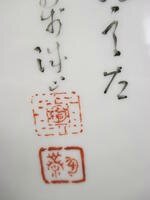Two famille-rose enameled porcelain plaques depicting Buddhist figures, Wang Qi, dated by inscription to 1932
Two famille-rose enameled porcelain plaques depicting Buddhist figures, Wang Qi, dated by inscription to 1932. Photo Bonhams.
Both of tall rectangular shape, the first depicting the Budai Heshang in a valley setting seated upon his eponymous cloth sack weighing down a young boy struggling to escape from under the weight of the animatedly yawning old monk; the second depicting an arhat seated in a forest grove, grimacing in pain while he picks his ear, his attention completely distracted from the dragon head emerging from the water coupe at his right knee; both plaques inscribed with a long calligraphic inscription including a renshen date (1932), the artists signature, and two seals reading Xichang Wang Qi and Tao mi. 32 1/4in (82cm) approximate heights of plaque only; 38 1/4in (97cm) heights inclusive of frames. Estimate US$ 60,000 - 80,000 (€44,000 - 58,000)
The Budai Heshang was a Five Dynasties/Ten Kingdoms era monk whose preternaturally gleeful demeanor caused him to be identified in Chinese folk religion as a reincarnation of the future Buddha Maitreya. According to numerous depictions throughout the Buddhist world, his unusually joyful personality attracted a coterie of small boys wherever he went.
This theme of a merry Maitreya/Budai at play with small children was one ceramics painter Wang Qi (1884-1937) explored extensively late in his career. For a porcelain plaque of the same size and subject matter with nearly identical seals and calligraphic style dated to the summer of the same year as the present lot, see Kwan, Simon Chinese Porcelain of the Republic Period: the Muwen Tang Collection Series volume 6 Hong Kong, 2008, pp. 118-119, fig. 30. For another plaque by Wang Qi showing two small boys with a standing Budai, see Tie Yuan and Xi Ming, Minguo Ciqi Jianding: Wenshi Kuanshi Banwei Beijing, 2004, p. 255, fig. 13.
Xi and Tie point out that it was after a 1916 trip by Wang Qi to Shanghai with another of the Zhushan Bayou Wang Dafan that Wang started to adopt the style of 18th century painter Huang Shen in his work (p. 12). This influence can be seen in the present lot on both of these plaques: impressionistic, whimsical, and exaggerated depictions of folkloric and/or mythological figures juxtaposed with long and uninhibited caoshu calligraphic inscriptions. Between the early 1930s his death Wang Qi's work in the style of Huang Shen would 'set a new standard for the Jingdezhen art world' (jingdezhen yitan bieshu yi zhi) (p. 12), and 'influence even already well-established [porcelain] artists.' (jiu lian yi chengming de yiren shou qi yingxiang) (p. 28).
Other late works by Wang Qi that have come up for auction include a large porcelain plaque depicting the Daoist immortal Li Tieguai, offered in our New Bond Street showrooms as lot 585, November 10th, 2011. For a smaller work also of Buddhist subject matter done in the same Huang Shen influenced style, see Sotheby's New York,19 March 2013, lot 249.
Bonhams. FINE CHINESE WORKS OF ART. San Francisco. 17 Dec 2013 - www.bonhams.com

/https%3A%2F%2Fprofilepics.canalblog.com%2Fprofilepics%2F1%2F0%2F100183.jpg)
/https%3A%2F%2Fstorage.canalblog.com%2F03%2F02%2F119589%2F96711876_o.jpg)
/https%3A%2F%2Fstorage.canalblog.com%2F11%2F31%2F119589%2F94773502_o.jpg)
/https%3A%2F%2Fstorage.canalblog.com%2F20%2F83%2F119589%2F94772815_o.jpg)
/https%3A%2F%2Fstorage.canalblog.com%2F26%2F72%2F119589%2F75604929_o.jpg)
/https%3A%2F%2Fstorage.canalblog.com%2F59%2F60%2F119589%2F26458628_o.jpg)






/http%3A%2F%2Fstorage.canalblog.com%2F98%2F98%2F119589%2F121234210_o.png)
/http%3A%2F%2Fstorage.canalblog.com%2F09%2F74%2F119589%2F109869904_o.jpg)
/http%3A%2F%2Fstorage.canalblog.com%2F00%2F40%2F577050%2F38938930_p.jpg)
/http%3A%2F%2Fstorage.canalblog.com%2F59%2F39%2F119589%2F129631842_o.jpg)